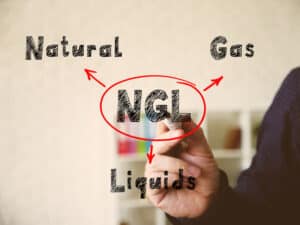LNG vs NGL – Natural Gas Liquids – Liquid Natural Gas

NGL – Natural Gas Liquids (NGL) are also called Condensate. They are produced during the crude oil refining process.
Natural gas liquids (NGL) are then further separated into various products including propane, butane and gasoline.
Natural Gas Liquids (NGL) is different from LNG, CNG and LPG, although LPG is produced from natural gas liquids – NGL.
Talk about alphabet soup…
I’m “Not Gonna Lie”, so here is the straight story…
NGL Meaning: Acronym for Not Gonna Lie & Natural Gas Liquids
NGL meaning is as an acronym – “Not Gonna Lie” – in the internet slang definition. NGL definition is also as the acronym for “Natural Gas Liquids”.
Natural Gas Liquids (NGL) include the typical LPG gases: propane, butane and isobutane.
Natural gas liquids (NGL), also called Condensate, include other hydrocarbons, too.
But not all natural gas liquids are LPG.
Amazingly, LNG – liquid natural gas – is NOT a natural gas liquids (NGL).
Seriously confusing, right?
Add to that the NGL meaning, in internet slang, is “Not Gonna Lie”.
It’s confusing to me and I wrote it!
Well, let’s try to fix that…
What are Natural Gas Liquids – NGL?
Natural gas liquids (NGL) are the refined natural gas processed into liquid by cooling it to −161°C.
The refining occurs in a processing plant, where impurities are removed and the dry methane gas is separated from the natural gas liquids (NGL).
Raw natural gas, as it comes out of the ground, contains a number of gases and compounds, as well as impurities.
However, it is mostly methane (CH4) gas, which is more commonly known as natural gas.
The raw natural gas must be processed to obtain pipeline quality clean, dry natural gas (methane).
NGLs – Natural Gas Liquids – or condensate are the heavier hydrocarbons that remain after the methane (natural gas) is removed.
Natural Gas Liquids – NGL Terminology Chart
NGLs |
Non-NGLs |
| LPG | Natural Gas |
| Condensate | Methane |
| Propane | LNG – Liquefied Natural Gas |
| Butane | CNG – Compressed Natural Gas |
| Isobutane | |
| Ethane | |
| Ethene | |
| Propene | |
| Butadiene | |
| Pentene | |
| Pentane | |
| Pentanes Plus |
What Compounds are Considered Natural Gas Liquids?
 Natural gas liquids (NGL) include propane, butane, isobutane, ethane, ethene, propene, isobutene, butadiene, pentane, pentene and pentanes plus.
Natural gas liquids (NGL) include propane, butane, isobutane, ethane, ethene, propene, isobutene, butadiene, pentane, pentene and pentanes plus.
Natural gas liquids (NGL) may also be referred to as Condensate, just to further complicate the name game!
Natural gas liquids (NGL) range from 1% to 10% of the raw natural gas flow.
Pentanes Plus is a mixture of the heavier liquid hydrocarbons, mostly pentanes, hexane, heptane, octane and heavier.
These are heavier liquid hydrocarbons with typically between 5 and 10 carbon atoms in each molecule.
Natural gasoline is the largest component of pentanes plus.
Natural gas liquids (NGL) are liquid at ambient temperatures, where LNG – liquid natural gas is only liquid when chilled cryogenically.
Raw natural gas also contains impurities including water vapour, hydrogen sulphide (H2S), carbon dioxide, helium, nitrogen, and other compounds that must be removed to meet quality standards.
What are Natural Gas Liquids
 Natural gas liquids (NGL) include propane, butane and isobutane, as well as mixtures of these gases, are the three gases that are typically sold as LPG – Liquefied Petroleum Gas.
Natural gas liquids (NGL) include propane, butane and isobutane, as well as mixtures of these gases, are the three gases that are typically sold as LPG – Liquefied Petroleum Gas.
Natural gas liquids (NGL) are a group of flammable hydrocarbon gases that are liquefied through pressurisation and commonly used as fuel.
Natural gas liquids (NGL) are LPG gases can all be compressed into liquid at relatively low pressures and is generally stored in steel vessels ranging from small BBQ gas bottles to larger gas cylinders and LPG bulk storage tanks.
Natural gas liquids (NGL) and LPG come from petroleum refining as well as natural gas processing.
Natural Gas Liquids Fractionation – Stripped from Raw Natural Gas
Natural gas liquids (NGL) fractionation is the process used to separate natural gas liquids (NGL) from natural gas.
Liquid fractionation columns or towers are used to isolate the natural gas liquids (NGL) from the methane, in a natural gas plant.
In natural gas processing, the gas/oil mixture is piped out of the well and into a gas trap, which separates the stream into crude oil and “wet” gas, which contains natural gas liquids (NGL) and natural gas.
The heavier crude oil sinks to the bottom of the trap and is then pumped into an oil storage tank for refining.
The “wet” gas, off the top of the gas trap, is processed to separate the gasoline (petrol) from the natural gas and natural gas liquids (NGL) .
Processing the Methane (Dry Natural Gas)
 Impurities such as water, carbon dioxide, nitrogen and hydrogen sulphide must be removed before either the natural gas (methane) or natural gas liquids (NGL) can be used. Some of these can be sold as by-products.
Impurities such as water, carbon dioxide, nitrogen and hydrogen sulphide must be removed before either the natural gas (methane) or natural gas liquids (NGL) can be used. Some of these can be sold as by-products.
The refined and purified natural gas, which is mostly methane, is fed into the pipelines that supply our cities and towns.
Distribution of refined natural gas (methane) is typically handled by gas utility companies.
LNG (Liquid Natural Gas)
Methane gas is processed into LNG – liquid natural gas by cooling it to −161°C, at which point it becomes a liquid.
Liquid natural gas – LNG reduces the volume of the natural gas by a factor of more than 600 times as it goes from its gaseous state to liquid.
That’s like going from a beach ball to a ping pong ball.
LNG – liquid natural gas reduced volume facilitates economical transport by sea or road.
Common liquid natural gas – LNG uses include industrial applications and long haul trucking.
The technology involved with LNG liquid natural gas is generally not cost effective for small volume users, such as homes and small businesses.
Processing the Natural Gas Liquids & LPG
Natural gas liquids processing involves the separation and collection of the gas from its petroleum base.
involves the separation and collection of the gas from its petroleum base.
About 60% is produced from the natural gas stream that comes out of the wellhead.
The other 40% is produced during the crude oil refining process.
The natural gas liquids (NGL) as LPG must be separated from an intricate mixture of hydrocarbons, which includes the methane, ethane, ethene, propene, isobutene, butadiene, pentane, and pentene.
The plants that do the processing are frequently called “stripper plants”, as the natural gas liquids (NGL) are stripped from the natural gas flow.
Impurities must also be removed from the propane and butane or they will prevent the LPG natural gas liquids (NGL) from liquefying properly.
The refrigeration technique is common for recovery of natural gas liquids from a natural gas stream.
With this technique, they refrigerate the gas stream to obtain the natural gas liquids (NGL) .
Refrigeration is employed in three different processes: expander plants, low temperature separation and combined processes.
Other separation techniques may also be employed, including lean oil absorption.
This natural gas liquids (NGL) can be used as an LPG mixture or further separated into propane, butane and isobutane, as needed.
The LPG enters its own distribution network, where it eventually finds its way to end users, including home LPG and commercial LPG users all around Australia and the world.
Uses of Natural Gas Liquids
Natural gas liquids (NGL) constituent Ethane (C2H6) is commonly used in the in the petrochemical industry to produce ethylene, which is used to make plastics like polyethylene.
 Natural gas liquids (NGL) – Propane (C3H8) or LPG is used as a fuel for many residential, commercial and agricultural heat applications, including cooking, hot water systems and heating.
Natural gas liquids (NGL) – Propane (C3H8) or LPG is used as a fuel for many residential, commercial and agricultural heat applications, including cooking, hot water systems and heating.
It is also employed as a propellant, refrigerant, vehicle fuel and petrochemical feedstock.
Natural gas liquids (NGL) – Butane (n-butane) (C4H10) is commonly used as a fuel, propellant and refrigerant, as well as a petrochemical feedstock.
Isobutane (i-butane) is an isomer of butane.
So, it has the same chemical formula as butane – C4H10 – but has a different arrangement of its atoms.
Isobutane is commonly used as a refrigerant and a propellant.
Pentane (C5H12) is are also used in the petrochemical industry to make things like polystyrene foam and other plastic foams.
Hexane (C6H14) is used in gasoline blending, solvents, and other chemical applications.
Heptane (C7H16) is commonly used in solvents. It is undesirable in gasoline, as it is at the zero point of the octane rating scale.
Octane (C8H18) and its isomer, iso-octane, are used as a major components in gasoline (petrol), as they have anti-knock properties.
What is the Difference Between LNG, LPG and NGLs? (LNG vs LPG vs NGL)
As already discussed, LNG is liquefied natural gas.
For LPG versus LNG, LPG is propane versus LNG, which is methane.
It is methane that is cryogenically cooled to become a liquid.
LPG is propane and/or butane.
It is liquefied petroleum gas stored under low pressure in pressure vessels.
Natural gas liquids (NGL) are the natural gas condensates including include propane, butane, isobutane, ethane, ethene, propene, isobutene, butadiene, pentane, pentene and pentanes plus.
Natural gas liquids (NGL) are stripped from the raw natural gas flow when the natural gas is processed.
Final Thoughts on Natural Gas Liquids – NGL Meaning
I’m Not Gonna Lie, “Natural gas liquids” is becoming a more commonly referenced term, where previously it was just used within the energy industry.
Natural gas liquids (NGL) may never be as common as the internet slang “Not Gonna Lie” for NGL, but it is important in the energy business.
The terms natural gas liquids (NGL) and LPG are not exactly synonymous but the common LPG gases are included within the wider group of natural gas liquids (NGL).
Natural gas liquids (NGL) includes ethane, the traditional LPG gases, and the heavier liquid hydrocarbons.
- BBQ – Gas and Charcoal BBQ Features – Charcoal BBQ vs Gas BBQ Comparison - March 31, 2025
- GPL Gas (GPL Fuel) – GLP Gas – LPG Gasul: GLP-GPL Gas Station - March 26, 2025
- Think LPG When Building a New Home - February 26, 2025
Steve Reynolds
Technical Consultant
Steve Reynolds is a leading expert in the LPG industry with over 22 years of experience. As part of the national management team at ELGAS, Steve ensures the safe and efficient storage, handling, and transportation of LPG. He serves as the lead investigator for incidents and collaborates with authorities on industry developments.
Steve is a technical advisor to Standards Australia and Gas Energy Australia (GEA), and an active member of the World LPG Association (WLPGA), contributing to global standards and technical reviews. He holds a BSc. (Hons) in Industrial Chemistry from UNSW and has held senior safety and technical roles at ELGAS, making him a trusted authority in LPG safety and standards.

